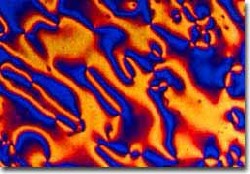Electrons Come to Order

Electrons don’t normally know one direction from another, so researchers were perplexed a few years ago when they found a cold plane of electrons suddenly choosing to conduct many times better in one direction than in the perpendicular one. Maybe they could acquire a preferred orientation by acting like liquid crystals, theorists proposed. Now, in the 27 May print issue of PRL, a group reports it has worked this theory out well enough that experimenters may finally have some detailed signs to search for.
The puzzling result appeared when electrons were sandwiched between very smooth gallium arsenide semiconductor crystals and put under a magnetic field perpendicular to the plane–the famous quantum Hall state. When researchers chilled them and applied the right field strength, the electrons consistently chose one direction (with respect to the crystal axes) in which to dramatically maximize their conductivity [1]. The effect seemed similar to the alignment of domains in magnetic materials under an applied field or the electrically induced ordering of cigar-shaped liquid crystal molecules. But in these other examples, the particles have a preferred direction built in.
One way for electrons to pick out a direction is to line up in “charge density waves”–alternating rows of high and low electron density. Such striped states show up in a variety of systems where a long range, repulsive force competes with a short range, attractive one. For electrons, the Pauli exclusion principle paradoxically leads to an effective attraction that balances the particles’ electrostatic repulsion at short distances. Researchers believe this tension results in stripes that are stable under magnetic fields of a certain strength. Fluctuations and branches in these stripes should create a maze riddled with patches of stripes pointing in various directions, like randomly oriented liquid crystal molecules.
Theorists predicted that stripe patches should line up at low temperatures just as liquid crystal molecules do [2]. Now, Leo Radzihovsky of the University of Colorado in Boulder and Alan Dorsey of the University of Florida in Gainesville have added low temperature quantum corrections to this model, wringing some detailed predictions from it in the process. For instance, the stripes should oscillate like rows of corn in a breeze, and their theory describes the detailed properties of this vibration. To measure the effect, experimenters could follow the changes in acoustic waves traveling through gallium arsenide.
Mystery still surrounds one crucial ingredient in the mix, though. Whereas a magnetic field helps to align ferromagnetic atoms, “the field for the [electron stripe] liquid crystals is gallium arsenide itself,” says Dorsey. No one understands exactly how the asymmetric crystal influences the electrons.
According to Eduardo Fradkin of the University of Illinois in Urbana, the new model fills an important gap by describing how the stripe patches move quantum mechanically under a magnetic field. Testing the new theory, however, will be “a daunting prospect, but you can probably do it,” says Jim Eisenstein of the California Institute of Technology in Pasadena and a member of the team that first reported the effect. Already, in a paper submitted to Physical Review B [3] he and colleagues report a relationship between the applied magnetic field and the temperature at which the effect kicks in that supports the liquid crystal hypothesis, he says. “The evidence is that a quantum [liquid crystal] is really at the center of what’s going on here,” says Fradkin.
–JR Minkel
JR Minkel is a freelance science writer in New York City.
References
- M. P. Lilly et al., Phys. Rev. Lett. 82, 394 (1999)
- E. Fradkin and S. A. Kivelson, Phys. Rev. B 59, 8065 (1999)
- K.B. Cooper et al., Phys. Rev. B 65, 241313 (2002)
More Information
Focus story on the experimental result from 1999.


